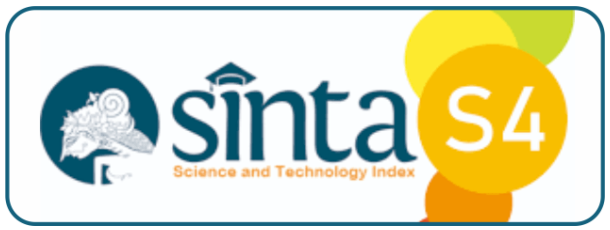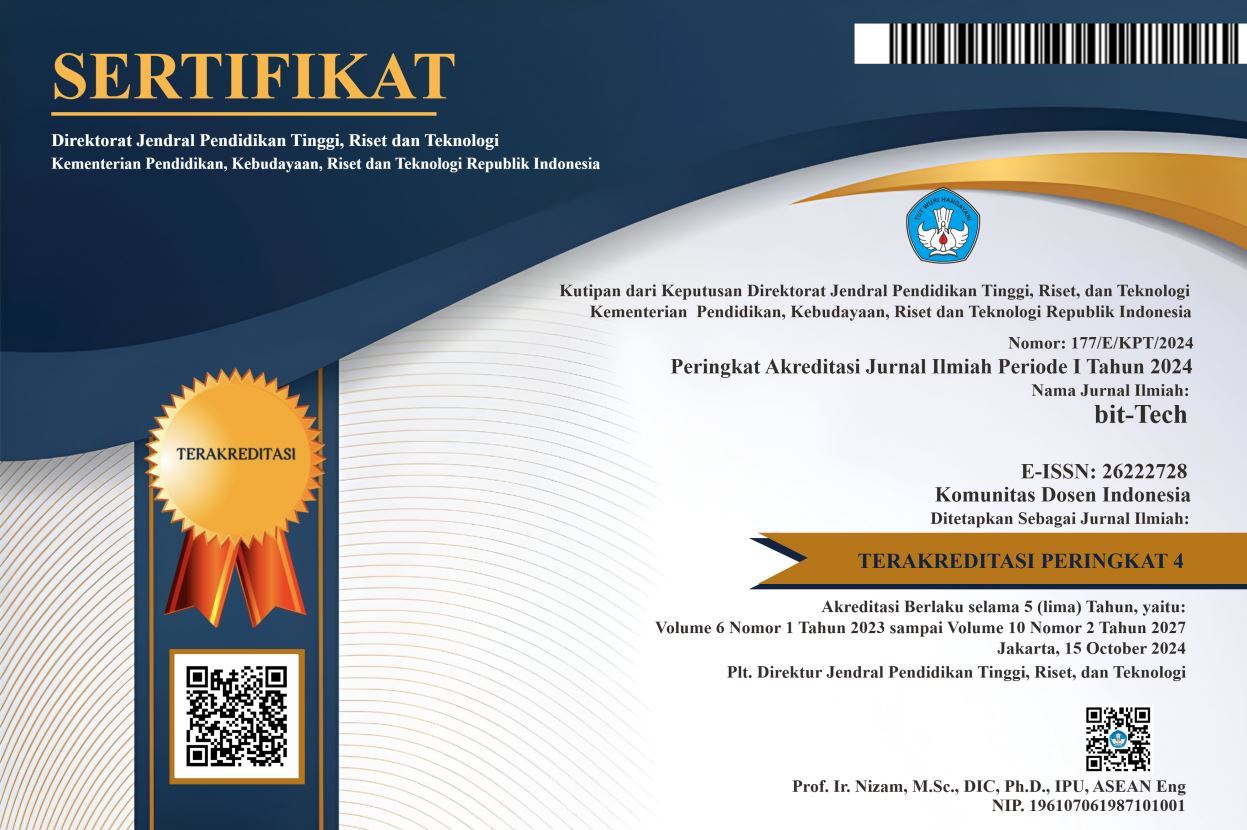Design of Diabetes Prediction Application Using K-Nearest Neighbor Algorithm
DOI:
https://doi.org/10.32877/bt.v6i2.939
Keywords:
Algorithm, Data Mining, Diabetes Prediction, Euclidian Distance, K-Nearest Neighbor
Abstract
The development of diabetes continues to increase accompanied by an increase in unhealthy lifestyles with a high number of cases, making diabetes need to be continuously researched and developed to obtain useful information in terms of research related to diabetes. This study aims to predict diabetes using the K-Nearest Neighbor Algorithm and make a simulation of checking the disease and test the quality of the K-Nearest Neighbor Algorithm for diabetes and make comparisons with the Naïve Bayes algorithm. The K-Nearest Neighbor algorithm is the method used in this study because it has the advantage of being able to train data that is fast, simple, and easy to learn. The way this algorithm works is by calculating the distance between each row of training data and test data based on a predetermined K value. In the process of using the K-Nearest Neighbor, there is a Z-Score normalization stage which is used to adjust the values for each attribute of diabetes symptoms so that they have a range of values that are not too far away. Based on the results of the research and testing of the K-Nearest Neighbor that has been carried out, an accuracy of 97.12% is obtained and the Area Under Curve value is 0.872 which is included in the good classification category and these results have a greater accuracy value compared to previous studies on the same disease, namely Diabetes with the Naïve Bayes algorithm which produces the most optimal accuracy of 87.69%.
Downloads
References
H. Sitorus, V. Yasin, and A. B. Yulianto, “Perancangan sistem pakar diagnosis penyakit diabetes berbasis web menggunakan algoritma naive bayes,” J. Sains dan Teknol. Widyaloka, vol. 1, pp. 135–144, 2022.
D. A. Agatsa, R. Rismala, and U. N. Wisesty, “Klasifikasi Pasien Pengidap Diabetes Metode Support Vector Machine,” e-Proceeding of Enginering, vol. 7, no. 1, pp. 2517–2525, 2020, [Online]. Available: https://openlibrarypublications.telkomuniversity.ac.id/index.php/engineering/article/view/11924/11786
L. Pebrianti, F. Aulia, H. Nisa, and K. Saputra, “Informasi Implementasi Metode Adaboost untuk Mengoptimasi Klasifikasi Penyakit Diabetes dengan Algoritma Naïve Bayes,” J. Sist. dan Teknol., vol. 7, no. 2, pp. 122–127, 2022, [Online]. Available: http://jurnal.unmuhjember.ac.id/index.php/JUSTINDO/article/view/8627%0Ahttp://jurnal.unmuhjember.ac.id/index.php/JUSTINDO/article/download/8627/4296
R. Oktorina, R. Sitorus, and L. Sukmarini, “Pengaruh Edukasi Kesehatan dengan Self Instructional Module Terhadap Pengetahuan Tentang Diabetes Melitus,” J. Endur., vol. 4, no. 1, pp. 171–183, 2019, doi: 10.22216/jen.v4i1.2995.
H. Adrianus and D. Lasut, “Penerapan Data Mining Untuk Memprediksi Penyakit Diabetes Menggunakan Algoritma Naive Bayes,” Algor, vol. 4, no. 2, pp. 75–85, 2023.
F. Irawan, T. Suprapti, and A. Bahtiar, “KLASIFIKASI ALGORITMA NAIVE BAYES DAN K-NEAREST NEIGHBOR,” J. Tek. Elektro dan Inform., vol. 18, no. 1, pp. 80–86, 2023.
A. N. Iffah’da and Anita Desiani, “Implementasi Algoritma K-Nearest Neighbor (K-NN) dan Single Layer Perceptron (SLP) Dalam Prediksi Penyakit Sirosis Biliari Primer,” J. Ilm. Inform., vol. 7, no. 1, pp. 65–74, 2022, doi: 10.35316/jimi.v7i1.65-74.
N. Ningsih, Aprianto, and Angeline, “Pendekatan Data Science untuk Deteksi Dini Diabetes Menggunakan Naive Bayes Classifier,” J. Inf. Syst. Graph. Hosp. Technol., vol. 05, no. 01, pp. 26–31, 2023.
C. Susanto, T. Taufiq, E. Hasmin, and K. Aryasa, “Sistem Pakar Prediksi Penyakit Diabetes Menggunakan Metode K-NN Berbasis Android,” CogITo Smart J., vol. 8, no. 2, pp. 359–370, 2022, doi: 10.31154/cogito.v8i2.406.359-370.
M. N. Maskuri, K. Sukerti, and R. M. H. Bhakti, “Penerapan Algoritma K-Nearest Neighbor ( KNN ) untuk Memprediksi Penyakit Stroke,” vol. 4, no. 1, pp. 130–140, 2022.
A. K. Hermawan and A. Nugroho, “Analisa Data Mining Untuk Prediksi Penyakit Ginjal Kronik Dengan Algoritma Regresi Linier,” Bull. Inf. Technol., vol. 4, no. 1, pp. 37–48, 2023.
G. Setiawan, D. S. D. Putra, and H. Wijaya, “Aplikasi Data Mining Berbasis Web Menggunakan Algoritma Apriori Untuk Analisa Pola Pembelian Barang Pada PT Menara Bahagia Bersama,” Algor, vol. 3, no. 2, pp. 1–11, 2022, doi: 10.31253/algor.v3i2.1020.
S. N. Sari, R. Kaban, A. Khaliq, and A. Andari, “Sistem Penjadwalan Mata Pelajaran Sekolah Menggunakan Metode Hybrid Artificial Bee Colony (HABC),” J. Nas. Teknol. Komput., vol. 2, no. 1, pp. 20–32, 2022, [Online]. Available: https://publikasi.hawari.id/index.php/jnastek/article/view/21
E. Budiarto, R. Rino, S. Hariyanto, and D. Susilawati, “Penerapan Data Mining Untuk Rekomendasi Beasiswa Pada SD Maria Mediatrix Menggunakan Algoritma C4. 5,” Algor, vol. 2, 2022, [Online]. Available: https://jurnal.buddhidharma.ac.id/index.php/algor/article/view/1019%0Ahttps://jurnal.buddhidharma.ac.id/index.php/algor/article/download/1019/638
K. Christoper, D. Lasut, and L. W.Kusuma, “Aplikasi Klasifikasi Kepribadian Manusia Menggunakan Algoritma Tree (C4.5) Berbasis Web,” J. Algor, vol. IV, no. 1, pp. 79–86, 2022.
D. Astuti, “Penentuan Strategi Promosi Usaha Mikro Kecil Dan Menengah (UMKM) Menggunakan Metode CRISP-DM dengan Algoritma K-Means Clustering,” J. Informatics, Inf. Syst. Softw. Eng. Appl., vol. 1, no. 2, pp. 60–72, 2019, doi: 10.20895/inista.v1i2.71.
A. Syarifah, A. A. Riadi, and A. Susanto, “Klasifikasi Tingkat Kematangan Jambu Bol Berbasis Pengolahan Citra Digital Menggunakan Metode K-Nearest Neighbor,” vol. 7, no. 1, pp. 27–35, 2022.
R. Annisa, “Analisis Komparasi Algoritma Klasifikasi Data Mining Untuk Prediksi Penderita Penyakit Jantung,” J. Tek. Inform. Kaputama, vol. 3, no. 1, pp. 22–28, 2019, [Online]. Available: https://jurnal.kaputama.ac.id/index.php/JTIK/article/view/141/156
Downloads
Published
How to Cite
Issue
Section
License
Copyright (c) 2023 bit-Tech : Binary Digital - Technology

This work is licensed under a Creative Commons Attribution-ShareAlike 4.0 International License.
I hereby assign and transfer to bit-Tech all exclusive copyright ownership rights to the above work. This includes, but is not limited to, the right to publish, republish, downgrade, distribute, transmit, sell, or use the work and other related materials worldwide, in whole, or in part, in all languages, in electronic, printed, or any other form of media, now known or hereafter developed and reserves the right to permit or license a third party to do any of the above. I understand that this exclusive right will belong to bit-Tech from the date the article is accepted for publication. I also understand that bit-Tech, as the copyright owner, has sole authority to license and permit reproduction of the article. I understand that, except for copyright, any other proprietary rights associated with the work (e.g. patents or other rights to any process or procedure) must be retained by the author. In addition, I understand that bit-Tech permits authors to use their papers in any way permitted by the applied Creative Commons license.


 DOI :
DOI :
 Abstract views: 136
/
Abstract views: 136
/  PDF downloads: 237
PDF downloads: 237











